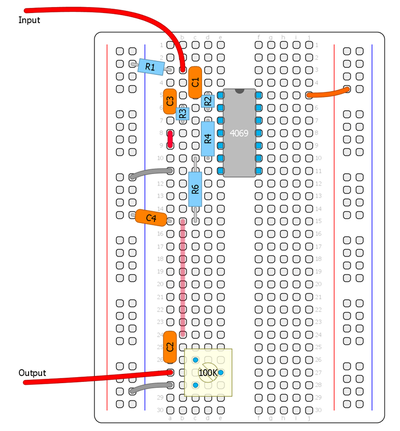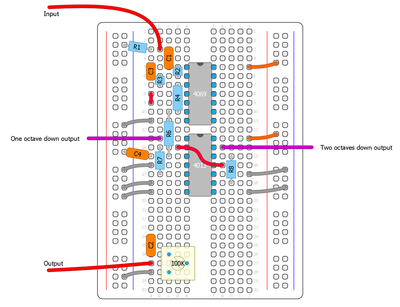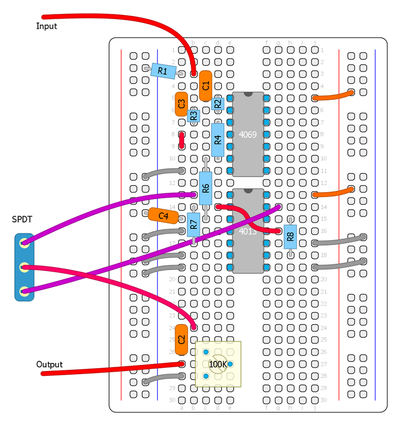If you want to learn more about the logic math behind the flip flop, I recommend this video: https://www.youtube.com/watch?v=PCT76PsDr6g
Here is a sound example of octave down with: 1. Bridge pickup, no filter 2. Bridge pickup with RC filter 3. Neck pickup with RC filter. Let's get the breadboard ready! We'll start out with the circuit we made in part two, then add the new section before the output capacitor. To keep it simple, the schematics will not show the "cmos'ifier" part or the output part. Lets add the RC filter first (R6/C4). 10K and 22nF-100nF is a good starting point. Then we'll add the octave down part. No decoupling capacitor after the schmitt trigger is needed. CMOS chips are make to interface with each other directly so decoupling caps are rarley needed, except for linear amplifiers, filters or special schmitt trigger operations. It's very forgiving this way.
Output controls You can use pots/trimmers as variable resistors or voltage dividers to have control over each octave or a switch to toggle between them, a blend pot/trimmer between straight square wave and octave down ect... Experiment with the controls that you want. Here are a few examples:
It works. :) I actually used this flip flop version for the sound example in the beginning of the post. This was very confusing to breadboard and I won't even try to make a breadboard diagram. It's not a very convenient method, unless you have a huge stash of schmitt triggers and diodes that you want to put to good use... I just wanted to show you what is possible. Post-filtering It can be a good idea to have a RC lowpass filter on the octave output if you want it to sound less synthy or harsh. It's common to filter out anything above around 100hz to make it blend better with a clean guitarsignal. Experiment! I'll stop here. This post became massive and took me a whole day, and I didn't even mention octave down by using gated oscillators, phase locked loops or shift registers. Maybe more about that in a later part. But in the next part I will cover LFO's and oscillators.
We will analyze the Flawed Logic Fuzz and we will breadboard a drone synth. UPDATED 2023-10-31: Some minor spelling fixes.
25 Comments
hymenoptera
9/16/2015 08:33:16 pm
Great stuff, thank you so much! I was struggling with chapter 8 "Digital Electronics" in Horrowitz and Hill's The Art Of Electronics until now. It's all starting to make sense. Can't wait to breadboard the rest of these examples!
Reply
thehallofshields
9/18/2015 03:34:46 pm
Thanks so much! I've been fascinated with Octave Down circuits for like 3 years but didn't have the know-how to bread-board one until now!
Reply
thehallofshields
9/18/2015 03:39:08 pm
I hope some of you guys out there are using the OC-2 ('clean') trick where you use a JFet Gate to add some dynamics back into your signal.
Reply
Ash
3/21/2016 07:51:23 am
Can we expect a part 4 in the series anytime soon? I love this blog. I am still fairly new to breadboarding so I am not only learning how cmos chips work in effects but also breadboarding techniques since you lay everything out so well.
Reply
3/23/2016 04:37:43 am
Hi Ash,
Reply
Ash
3/23/2016 03:34:00 pm
No worries my friend! Still plenty here to keep me busy.
Sergio
1/13/2017 10:46:17 am
Hallo. Great article, reading the 4024 part I get intrigued why I cant remember hearing about an octaver that reaches a 3 octaves down as it seems to be possible for it to reach. I should breadboard this. Has someone already tried? Does it barely sound? Or does it sound not very musical? Thanks a lot.
Reply
1/14/2017 04:32:52 am
Hi Sergio,
Reply
3/8/2017 12:59:42 pm
Hey Fredrik,
Reply
3/8/2017 01:25:11 pm
Hi Mike,
Reply
Shane
5/18/2017 09:21:42 pm
Great article, Have just been experimenting with using a CD4040 and getting some really crazy and fun results!
Reply
5/19/2017 09:04:47 am
Hi Shane,
Reply
Rhuan Cardilo
2/25/2018 06:33:18 pm
Hey Man, please continue with this series! It´s fantastic... I´m working with some pedals based on CMOS chips, and this is very inspiring... thanks so much, and, if possible, continue this great job... Greetings from Brazil!
Reply
golden axe
9/29/2018 01:00:46 am
amazing series of tutorials , been doing octave down with 4040 which is a dedicated cmos divider chip , you just need the clock and then youve got yourself 10 divisions down, very cool
Reply
9/30/2018 12:16:36 pm
Thanks, glad to hear that the tutorials are appreciated. :) Cheers / Fredrik
Reply
Quisiera saber si puedo hacer un octavador, ejemplo, de dos octavador abajo. Pero quisiera usar transistores, como el shoktave down, solo que fuera más como el BOSS OC-2, que es limpio y no suena fuzz, crees poder ayudarme. Sería genial con un diagrama que indique preamp, amp, effect, mixers, buffers,etc. Desde ya muchas gracias y que Dios te bendiga
Reply
Dan
2/19/2021 10:57:16 pm
In english you piece of shit.
Reply
cooper flagg
3/12/2024 10:15:57 am
fuck you
Albert
5/4/2020 08:50:00 am
Hello! Will you make an LFO workshop? It would be amazing
Reply
5/6/2020 07:21:10 am
Hi Fredrik.
Reply
5/9/2020 02:32:39 am
Hi Mariano,
Reply
Jim
6/12/2020 10:20:24 pm
I breaded boarded this circuit months ago with a CD4049 and CD4013. I think I ran a separate fuzz off the other side of the CD4049 and somehow got what I think was an 1.5 octave down....(is that a divide by 3?) which I ran underneath the straight fuzz. It was so cool. I took a picture of the breadboard, but a month later my hard drive crashed and lost it. and my child since decided to make a toy out of the breadboard.
Reply
6/15/2020 01:35:23 pm
Hi Jim!
Reply
Grillet Boris
4/28/2023 01:35:41 am
Can a BC107 be fitted to bistable schematic?
Reply
Leave a Reply. |


















